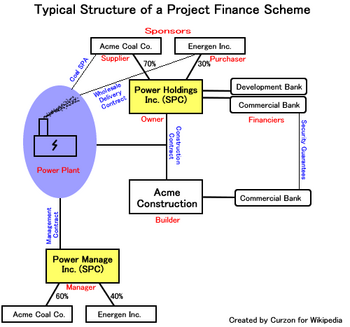
Project finance is the long-term financing of infrastructure and industrial projects based upon the projected cash flows of the project rather than the balance sheets of its sponsors. Usually, a project financing structure involves a number of equity investors, known as ‘sponsors’, as well as a ‘syndicate’ of banks or other lending institutions that provide loans to the operation. They are most commonly non-recourse loans, which are secured by the project assets and paid entirely from project cash flow, rather than from the general assets or creditworthiness of the project sponsors, a decision in part supported by financial modeling.
The financing is typically secured by all of the project assets, including the revenue-producing contracts. Project lenders are given a lien on all of these assets and are able to assume control of a project if the project company has difficulties complying with the loan terms.
The financing of long-term infrastructure, industrial projects and public services based upon a non-recourse or limited recourse financial structure where project debt and equity used to finance the project are paid back from the cashflow generated by the project.
Click Here To Read: Types of Commercial Real Estate Loans
Generally, a special purpose entity is created for each project, thereby shielding other assets owned by a project sponsor from the detrimental effects of a project failure. As a special purpose entity, the project company has no assets other than the project. Capital contribution commitments by the owners of the project company are sometimes necessary to ensure that the project is financially sound or to assure the lenders of the sponsors’ commitment. Project finance is often more complicated than alternative financing methods. Traditionally, project financing has been most commonly used in the extractive (mining), transportation, telecommunications industries as well as sports and entertainment venues.
Risk identification and allocation is a key component of project finance. A project may be subject to a number of technical, environmental, economic and political risks, particularly in developing countries and emerging markets. Financial institutions and project sponsors may conclude that the risks inherent in project development and operation are unacceptable (unfinanceable). “Several long-term contracts such as construction, supply, off-take and concession agreements, along with a variety of joint-ownership structures are used to align incentives and deter opportunistic behaviour by any party involved in the project. The patterns of implementation are sometimes referred to as “project delivery methods.” The financing of these projects must be distributed among multiple parties, so as to distribute the risk associated with the project while simultaneously ensuring profits for each party involved.
A riskier or more expensive project may require limited recourse financing secured by a surety from sponsors. A complex project finance structure may incorporate corporate finance, securitization, options (derivatives), insurance provisions or other types of collateral enhancement to mitigate unallocated risk.
Project finance shares many characteristics with maritime finance and aircraft finance; however, the later two are more specialized fields within the area of asset finance.
History
Limited recourse lending was used to finance maritime voyages in ancient Greece and Rome. Its use in infrastructure projects dates to the development of the Panama Canal, and was widespread in the US oil and gas industry during the early 20th century. However, project finance for high-risk infrastructure schemes originated with the development of the North Sea oil fields in the 1970s and 1980s. Such projects were previously accomplished through utility or government bond issuances, or other traditional corporate finance structures.
Project financing in the developing world peaked around the time of the Asian financial crisis, but the subsequent downturn in industrializing countries was offset by growth in the OECD countries, causing worldwide project financing to peak around 2000. The need for project financing remains high throughout the world as more countries require increasing supplies of public utilities and infrastructure. In recent years, project finance schemes have become increasingly common in the Middle East, some incorporating Islamic finance.
The new project finance structures emerged primarily in response to the opportunity presented by long term power purchase contracts available from utilities and government entities. These long term revenue streams were required by rules implementing PURPA, the Policy resulted in further deregulation of electric generation and, significantly, international privatization following amendments to the Public Utilities Holding Company Act in 1994. The structure has evolved and forms the basis for energy and other projects throughout the world. Project financing, Project finance, worldwide project funders,
business loan, business loan lender, business loan lenders, business loan companies
Parties to a project financing
There are several parties in a project financing depending on the type and the scale of a project. The most usual parties to a project financing are;
- Sponsor
- Lenders
- Financial Advisors
- Technical Advisors
- Legal Advisors
- Debt Financiers
- Equity Investors
- Regulatory Agencies
- Multilateral Agencies
Project development
Project development is the process of preparing a new project for commercial operations. The process can be divided into three distinct phases:
- Pre-bid stage
- Contract negotiation stage
- Money-raising stage
Financial model
A financial model is constructed by the sponsor as a tool to conduct negotiations with the sponsor and prepare a project appraisal report. It is usually a computer spreadsheet designed to process a comprehensive list of input assumptions and to provide outputs that reflect the anticipated real life interaction between data and calculated values for a particular project.
Properly designed, the financial model is capable of sensitivity analysis, i.e. calculating new outputs based on a range of data variations.
Contractual framework
The typical project finance documentation can be reconducted to four main types:
- Shareholder/sponsor documents
- Project documents
- Finance documents
- Other project documents
Engineering, procurement and construction contract
The most common project finance construction contract is the engineering, procurement and construction (EPC) contract. An EPC contract generally provides for the obligation of the contractor to build and deliver the project facilities on a turnkey basis, i.e., at a certain pre-determined fixed price, by a certain date, in accordance with certain specifications, and with certain performance warranties. The EPC contract is quite complicated in terms of legal issue, therefore the project company and the EPC contractor need sufficient experience and knowledge of the nature of project to avoid their faults and minimize the risks during contract execution.
An EPC contract differs from a turnkey contract in that, under a turnkey contract, all aspects of construction are included from design to engineering, procurement and construction whereas in the EPC contract the design aspect is not included. Alternative forms of construction contract are a project management approach and alliance contracting. Basic contents of an EPC contract are:
- Description of the project
- Price
- Payment
- Completion date
- Completion guarantee and Liquidated Damages (LDs):
- Performance guarantee and LDs
- Cap under LDs
Operation and maintenance agreement
An operation and maintenance (O&M) agreement is an agreement between the project company and the operator. The project company delegates the operation, maintenance and often performance management of the project to a reputable operator with expertise in the industry under the terms of the O&M agreement. The operator could be one of the sponsors of the project company or third-party operator. In other cases the project company may carry out by itself the operation and maintenance of the project and may eventually arrange for the technical assistance of an experienced company under a technical assistance agreement. Basic contents of an O&M contract are
Terms Sheet
Agreement between the borrower and the lender for the cost, provision and repayment of debt. The term sheet outlines the key terms and conditions of the financing. The term sheet provides the basis for the lead arrangers to complete the credit approval to underwrite the debt, usually by signing the agreed term sheet. Generally the final term sheet is attached to the mandate letter and is used by the lead arrangers to syndicate the debt. The commitment by the lenders is usually subject to further detailed due diligence and negotiation of project agreements and finance documents including the security documents. The next phase in the financing is the negotiation of finance documents and the term sheet will eventually be replaced by the definitive finance documents when the project reaches financial close.
Basic scheme

Project financing explained in 2020
For example, the Acme Coal Co. imports coal. Energen Inc. supplies energy to consumers. The two companies agree to build a power plant to accomplish their respective goals. Typically, the first step would be to sign a memorandum of understanding to set out the intentions of the two parties. This would be followed by an agreement to form a joint venture.
Acme Coal and Energen form an SPC (Special Purpose Corporation) called Power Holdings Inc. and divide the shares between them according to their contributions. Acme Coal, being more established, contributes more capital and takes 70% of the shares. Energen is a smaller company and takes the remaining 30%. The new company has no assets.
Power Holdings then signs a construction contract with Acme Construction to build a power plant. Acme Construction is an affiliate of Acme Coal and the only company with the know-how to construct a power plant in accordance with Acme’s delivery specification.
A power plant can cost hundreds of millions of dollars. To pay Acme Construction, Power Holdings receives financing from a development bank and a commercial bank. These banks provide a guarantee to Acme Construction’s financier that the company can pay for the completion of construction. Payment for construction is generally paid as such: 10% up front, 10% midway through construction, 10% shortly before completion, and 70% upon transfer of title to Power Holdings, which becomes the owner of the power plant.
Acme Coal and Energen form Power Manage Inc., another SPC, to manage the facility. The ultimate purpose of the two SPCs (Power Holding and Power Manage) is primarily to protect Acme Coal and Energen. If a disaster happens at the plant, prospective plaintiffs cannot sue Acme Coal or Energen and target their assets because neither company owns or operates the plant.
A Sale and Purchase Agreement (SPA) between Power Manage and Acme Coal supplies raw materials to the power plant. Electricity is then delivered to Energen using a wholesale delivery contract. The cash flow of both Acme Coal and Energen from this transaction will be used to repay the financiers.
Complicating factors
The above is a simple explanation which does not cover the mining, shipping, and delivery contracts involved in importing the coal (which in itself could be more complex than the financing scheme), nor the contracts for delivering the power to consumers. In developing countries, it is not unusual for one or more government entities to be the primary consumers of the project, undertaking the “last mile distribution” to the consuming population. The relevant purchase agreements between the government agencies and the project may contain clauses guaranteeing a minimum offtake and thereby guarantee a certain level of revenues. In other sectors including road transportation, the government may toll the roads and collect the revenues, while providing a guaranteed annual sum (along with clearly specified upside and downside conditions) to the project. This serves to minimise or eliminate the risks associated with traffic demand for the project investors and the lenders.
Minority owners of a project may wish to use “off-balance-sheet” financing, in which they disclose their participation in the project as an investment, and excludes the debt from financial statements by disclosing it as a footnote related to the investment. In the United States, this eligibility is determined by the Financial Accounting Standards Board. Many projects in developing countries must also be covered with war risk insurance, which covers acts of hostile attack, derelict mines and torpedoes, and civil unrest which are not generally included in “standard” insurance policies. Today, some altered policies that include terrorism are called Terrorism Insurance or Political Risk Insurance. In many cases, an outside insurer will issue a performance bond to guarantee timely completion of the project by the contractor.
Publicly funded projects may also use additional financing methods such as tax increment financing or Private Finance Initiative (PFI). Such projects are often governed by a Capital Improvement Plan which adds certain auditing capabilities and restrictions to the process.
Project financing in transitional and emerging market countries are particularly risky because of cross-border issues such as political, currency and legal system risks. Therefore, mostly requires active facilitation by the government.
Grand City Investment Limited is a Licensed Money Lender that was incorporated in Hong Kong on MAY 29, 1984 with Company Registration No. 0137353 under the Money Lenders Ordinance (Chapter 163 of the laws of Hong Kong). We are the premier provider of Trade Finance, Recourse Loan, Non Recourse Loans, Insurance, Investments, Wealth Management, Portfolio Management, Trade Platforms, Private Placement Programs as well as the issuance and monetization of Bank Instruments such as Standby Letter of Credit (SBLC), Bank Guarantees (BG), Usance LC, Letters of Credit, Differed Letters of Credit and Funding for companies, SME’s and private individuals.
These Bank Instruments are issued through top AAA rated banks such as Citibank New York, Chase Bank, Welsfargo Bank, Bank of America, HSBC Hong Kong or HSBC London, Barclays bank London, Standard Chartered Bank London, Dubai or Hong Kong, UBS Switzerland, Deusche Bank AG Germany etc.
Our bank financial instruments are Cash-Backed and Stand as Obligation from our Bank on behalf of our Clients for their Credit needs, Business and Project Funding. All our Bank Instruments can be used to secure Funding for Projects, Business Expansions and Private Placement Programs (PPP).
We can help you to obtain financing for your business or projects, activate credit lines, issue & provide Letters of credit, BG or SBLC for you, provide loans against financial instruments, and monetize financial instruments.
OUR SERVICES INCLUDES BUT NOT LIMITED TO THE FOLLOWING:
- Loans: (Personal / Business Loans, Secured / Unsecured Loans, Recourse / Non Recourse Loans etc)
- Bank Guarantees: (Performance Guarantee / Tender Bond Guarantee / Advance Payment Guarantee)
- Letters of Credit (Red Clause Letters of Credit, Usance LC, SBLC, DLC, L/C etc)
- Proof of Funds (POF) Messages: Pre Advice Message / Bank Comfort Letters
- Purchase Bank Instruments (Bank Guarantees and Standby Letter of Credit)
- Lease Bank Instruments (BG, SBLC, DLC, Letters of Credit)
- Wealth Management / Portfolio Management
- Insurance & Underwriting Services
- PPP and Trading Platforms
- Corporate Finance
- Investments
NOTICE TO BROKERS/AGENTS/COMPANY REPS: We value and appreciate brokers who are direct to their clients. New brokers are welcomed and compensated with between 1% to 2% commission on every deal. Here are a few of the many benefits of being a Grand City Investment broker:
- Professional Support for brokers
- Earn between 1% to 2% Commission on Every Deal
- No Broker Chains, So please Be Direct to your clients
- Brokers are 100% Protected Against Possible Circumvention.
- Wide Range of Financial Instruments to choose from such as bg sblc issuance & Monetization Programs.

Comments (1)Subscribe to CommentsComment